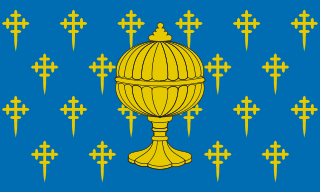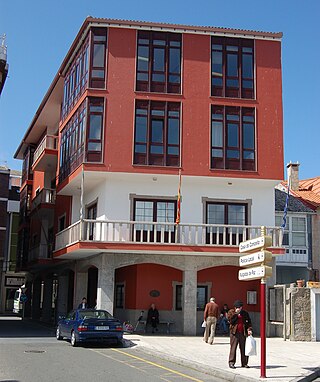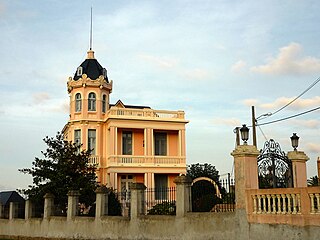
Galicia is an autonomous community of Spain and historic nationality under Spanish law. Located in the northwest Iberian Peninsula, it includes the provinces of A Coruña, Lugo, Ourense, and Pontevedra.

The province of A Coruña is the northwesternmost province of Spain, and one of the four provinces which constitute the autonomous community of Galicia. This province is surrounded by the Atlantic Ocean to the west and north, Pontevedra Province to the south and Lugo Province to the east.

Andrade is a surname of Galician origin, which emerged in the 12th century as the family name of the knights and lords of the small parish of San Martiño de Andrade, in the municipality of Pontedeume. The first mention of this small territory is to be found in the documentation of the monastery of San Xoán de Caaveiro, and belong chronologically to the 9th century. It was part of the region of Pruzos, which was created as an administrative and ecclesiastical territory of Kingdom of Galicia in the sixth century by King Teodomiro through a document written in Latin called Parrochiale suevum, Parochiale suevorum or Theodomiri Divisio. From the 12th century Pruzos, and therefore Andrade, were integrated into the county of Trastámara that belonged to the lineage Traba, the most powerful Galician family. By this same time the family group: Fortúnez, begins to unite their names Andrade as surname, since in this parish their family home was located. The knights of Andrade were faithful vassals of their lords the Counts of Trastámara throughout the middle centuries of the Middle Ages.

Mondoñedo is a small town and municipality in the Galician province of Lugo, Spain. As of 2009, the town has a population of 4,508. Mondoñedo occupies a sheltered valley among the northern outliers of the Cantabrian Mountains. Despite being the core of the region of A Mariña, it is the city with the fifth biggest population after Viveiro, Ribadeo, Foz and Burela.

Mailoc or Maeloc was a 6th-century bishop of Britonia, a settlement founded by expatriate Britons in Galicia, Spain. He represented his diocese, referred to as the Britonensis ecclesia or "Britonnic church", at the Second Council of Braga in 572. Records of the council refer to his see, the sedes Britonarum, which may have been seated at the monastery of Saint Mary of Britonia. Mailoc's name is clearly Brythonic, deriving from the Celtic *Maglācos, thereby providing further evidence for the Britonnic presence in the area, but he is the only one to have a Celtic name.

The Iberian Peninsula has been inhabited for at least 500,000 years, first by Neanderthals and then by modern humans.

The Kingdom of Galicia was a political entity located in southwestern Europe, which at its territorial zenith occupied the entire northwest of the Iberian Peninsula. It was founded by the Suebic king Hermeric in 409, with its capital established in Braga. It was the first kingdom that officially adopted Catholicism. In 449, it minted its own currency. In 585, it became a part of the Visigothic Kingdom. In the 8th century, Galicia became a part of the newly founded Christian Kingdom of Asturias, which later became the Kingdom of León, while occasionally achieving independence under the authority of its own kings. Compostela became the capital of Galicia in the 11th century, while the independence of Portugal (1128) determined its southern boundary. The accession of Castilian King Ferdinand III to the Leonese kingdom in 1230 brought Galicia under the control of the Crown of Castile.

Álvaro Cunqueiro Mora was a Galician novelist, poet, playwright, and journalist. He is the author of many works in both Galician and Spanish, including Merlín e familia. He was a cofounder of the Galician Writers Association. In 1991, Galician Literature Day was dedicated to him.

Britonia is the historical, apparently Latinized name of a Celtic settlement by Romano-Britons on the Iberian peninsula following the Anglo-Saxon settlement of Britain. The area is roughly analogous to the northern parts of the modern provinces of A Coruña and Lugo in the autonomous community of Galicia, Spain.

The Cíes Islands are an archipelago off the coast of Pontevedra in Galicia, Spain, in the mouth of the Ria de Vigo. They were declared a Nature Reserve in 1980 and are included in the Atlantic Islands of Galicia National Park created in 2002.

Muxía is a coastal town and municipality in the province of A Coruña in the autonomous community of Galicia in northwestern Spain. It belongs to the comarca of Fisterra. It is one of the final destinations for pilgrims on the Way of St. James after visiting the shrine of the apostle Saint James the Great in Santiago de Compostela.

Barreiros is a municipality in the Spanish province of Lugo. This municipality is closely linked to the history of the province from pre-Roman times. It has a geographical range extending from the valleys to the mountains and from the plains to the coast with high cliffs and long beaches.

The Atlantic Islands of Galicia National Park is the only national park located in the province of Pontevedra, in the autonomous community of Galicia, Spain. It comprises the archipelagos of Cíes, Ons, Sálvora and Cortegada. The park covers a land area of 1,200 ha and a sea area of 7,200 ha. It is the tenth most visited national park in Spain. It was the thirteenth national park to be established in Spain. Since 2021 it has been designated as a protected Ramsar site.

Saint Rudesind was a Galician bishop and abbot. He was also a regional administrator and military leader under his kinsmen, the Kings of León.
Oveco was the Bishop of Oviedo from 913/4, whose episcopate lasted almost half a century. Despite his longevity he is a relatively obscure figure. His origins lie in the same landed and wealthy aristocratic family as those of the Count Piniolo (Piñolo) who founded the monastery of San Juan Bautista de Corias. While the city of Oviedo and its diocese were overshadowed at the time of Oveco's election, at the height of his career, during the turbulent reign of Ramiro II, he was the senior bishop of the realm and his city was labelled the sedem regum.

The Abbey of San Juan Bautista de Corias is a former Benedictine monastery in Corias in Cangas del Narcea (Asturias), Spain, on the right bank of the Narcea River, dedicated to Saint John the Baptist. Today it is a historic site of the province, informally known as "the Asturian Escorial", due to the burial there of King Bermudo I of Asturias and his family.

Pedro Fróilaz de Traba was the most powerful secular magnate in the Kingdom of Galicia during the first quarter of the twelfth century. According to the Historia compostelana, he was "spirited ... warlike ... of great power ... a man who feared God and hated iniquity," for Diego Gelmírez himself had "fed him, like a spiritual son, with the nutriment of holy teaching." Brought up at the court of the Emperor Alfonso VI, Pedro raised the future Emperor Alfonso VII in his household. Around the latter he and Diego formed a "Galician party" that dominated that region during the turbulent reign of Urraca (1109–26). In September 1111 they even had the child Alfonso crowned king at Santiago de Compostela, but it was Pedro who was imperator in orbe Galletiae.
Saint Gonzalo, a medieval Galician nobleman and clergyman, was the long-serving Bishop of Mondoñedo from 1071. According to one modern source he was a brother of Pedro Fróilaz de Traba. If he was elected at the canonical age of thirty, he would have been born in 1040 or 1041, which would in turn support the contemporary contention that he was old in 1104–5, but cast doubt on his relationship with Pedro Fróilaz. Perhaps he was a more distant relative of the same family, the budding House of Traba.

The Island of San Simón, which alongside San Antón and other islets, is part of the San Simón archipelago in the Vigo estuary, Spain. The islands are one of five parts of the parish of Cesantes in the municipality of Redondela. As of 2021, San Simón is uninhabited.

The Tambo Island is an island in the middle of the Pontevedra bay, in Spain. It belongs to the municipality of Poio, from which it is separated by a 1.1 km long but shallow channel. Its surface area is 0.28 km², with a maximum height of 80 m, although its entire central part is over 50 metres high. Its perimeter reaches 4 km.



















